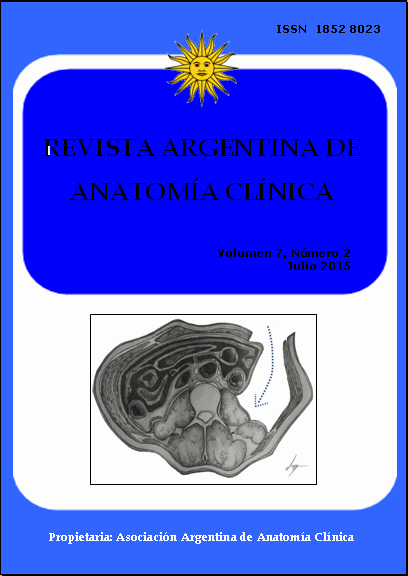INTERVERTEBRAL VEINS DIRECTLY CONNECTING THE VERTEBRAL VENOUS SYSTEM TO THE AZYGOS VENOUS SYSTEM RATHER THAN THE PROXIMAL END OF THE POSTERIOR INTERCOSTAL VEINS. Venas intervertebrales conectando directamente el sistema venoso vertebral al sistema venoso
DOI:
https://doi.org/10.31051/1852.8023.v7.n2.14171Palabras clave:
Azygos, intervertebral, posterior intercostal, Thiel-embalmed, thoracic, Ácigos, Intercostal posterior, embalsamamiento Thiel, torácico.Resumen
La estructura de las venas de la cavidad torácica varía significativamente en función de sus conexiones. Treinta cadáveres embalsamados con la técnica de Thiel fueron disecados (18 mujeres, 12 hombres), con edades comprendidas entre 48 y 98 años (media 81.3±12.40). Los pulmones, el corazón, la aorta torácica, el esófago y la pleura parietal fueron cuidadosamente retirados para permitir la visualización de las venas ácigos, hemiácigos y hemiácigos accesoria así como el conducto torácico. En la mayoría de los especímenes (21) se encontró que las venas intervertebrales estaban directamente conectadas con el sistema venoso ácigos en vez de con la parte terminal proximal de las venas intercostales posteriores. Se observó también que dicha distribución es más común en el lado derecho, pero no en todos los niveles vertebrales. Estas conexiones podrían jugar un rol en la regulación del volúmen de sangre entre los sistemas venosos ácigos y vertebral: también podrían actuar como vías metastásicas entre las regiones torácica y abdominal. Dado que su aspecto es bastante similar al de los vasos intercostales posteriores, es importante que los cirujanos sean conscientes de esta variación para evitar lesiones que induzcan hematomas postoperatorios.
Veins in the thoracic cavity are highly variable in terms of their communications. Thirty Thiel-embalmed cadavers were dissected (18 females and 12 males), ranging in age from 48 to 98 years old (mean 81.3±12.40). The lungs, heart, thoracic aorta, oesophagus and parietal pleura were removed carefully to expose the azygos, hemiazygos, accessory hemiazygos veins and thoracic duct. In most specimens (21) intervertebral veins were connected directly to the azygos venous systems rather than the proximal end of the posterior intercostal veins. This presentation was observed to be more common on the right side, but not at all vertebral levels. These communications could play a role in regulating blood volume between the azygos and vertebral venous systems; they may also act as metastatic pathways between the thoracic and abdominal regions. As they mimic posterior intercostal vessels, it is important for surgeons to be aware of this variation to avoid injuries leading to postoperative hematomas.
Referencias
de Brux JL, Subayi JB, Pegis JD. Pillet J. 1995. Retrograde cerebral perfusion: Anatomic study of the distribution of blood to the brain. Ann Thorac Surg 60: 1294–98.
Drake RL, Vogl W, Mitchell A, Gray H. 2005. Gray's Anatomy for Students, Philadelphia, Elsevier Churchill Livingstone, 197.
Groen RJM, Groenewegen HJ, van Alphen AM, Hoogland PVJM. 1997. Morphology of the human internal vertebral venous plexus: A cadaver study after intravenous Araldite CY 221 injection. Anat Rec 249: 285–94.
Gupta RGD, Batra A, Swami S. 2014. Atypic drainage pattern of posterior intercostal veins into the azygos venous system. Int J Anat Res 2: 740–43.
Herlihy WF. 1947. Revision of the venous system: The role of the vertebral veins. Med J Aus 1: 661–72.
Hoogland PV, Wessels Q, Vorster W, Groen RJM, Wettstein R, Greyling LM, Kotze SH. 2013. The posterior intercostal vein: a thermoregulatory gateway to the internal vertebral venous plexus. Clin Anat, 26: 735–40.
Ichikawa T, Endo J, Koizumi J, Ro A, Kobayashi M, Saito M, Kawada S, Hashimoto T, Imai Y. 2008. Visualization of the azygos arch valves on multidetector-row computed tomography. Heart Vessels 23: 118–23.
Maros T. 1981. Data regarding the typology and functional significance of the venous valves. Morphol Embryol 27: 195–214.
Snell R. 2004. Clinical Anatomy, Philadelphia, Lippincott, Williams and Wilkins, 132.
Standring S, Collins P, Crossman A, Gatzoulis M, Healy J, Johnson D, Mahadevan V, Newell R, Wigley C. 2008. Gray's Anatomy: The Anatomical Basis of Clinical Practice, Elsevier Churchill Livingstone, 205-10.
Yeh BM, Coakley FV, Sanchez HC, Wilson MW, Reddy GP, Gotway MB. 2004. Azygos arch valves: prevalence and appearance at contrast enhanced CT. Radiology 230: 111–15.
Descargas
Publicado
Número
Sección
Licencia
Los autores/as conservarán sus derechos de autor y garantizarán a la revista el derecho de primera publicación de su obra, el cuál estará simultáneamente sujeto a la Licencia de reconocimiento de Creative Commons que permite a terceros compartir la obra siempre que se indique su autor y su primera publicación en esta revista. Su utilización estará restringida a fines no comerciales.
Una vez aceptado el manuscrito para publicación, los autores deberán firmar la cesión de los derechos de impresión a la Asociación Argentina de Anatomía Clínica, a fin de poder editar, publicar y dar la mayor difusión al texto de la contribución.



